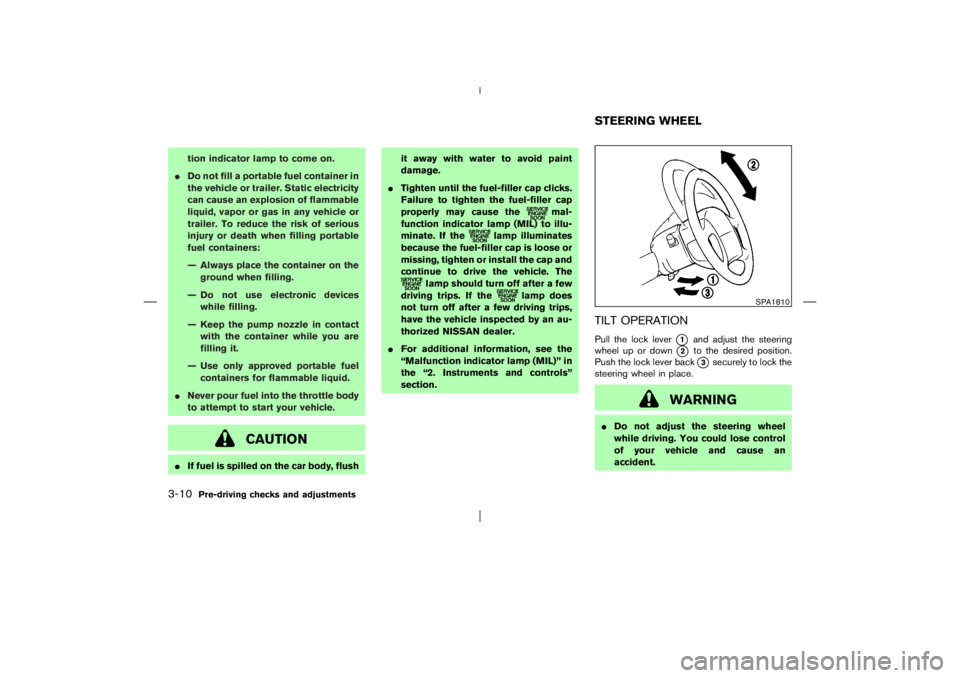Page 114 of 281

OPENING FUEL-FILLER DOORTo open the fuel-filler door, pull up the opener
lever. To lock, close the fuel-filler door securely.
FUEL-FILLER CAPThe fuel-filler cap is a ratcheting type. Turn the
cap counterlockwise
�1
to remove. Tighten the
cap clockwise
�2
until ratcheting clicks, more
than twice, after refueling.
Put the fuel-filler cap on the cap holder while
refueling.WARNING
�Gasoline is extremely flammable and
highly explosive under certain condi-tions. You could be burned or seri-
ously injured if it is misused or mis-
handled. Always stop the engine and
do not smoke or allow open flames
or sparks near the vehicle when refu-
eling.
�Fuel may be under pressure. Turn the
cap a third of a turn, and wait for any
hissing sound to stop to prevent fuel
from spraying out and possible per-
sonal injury. Then remove the cap.
�Do not attempt to top off the fuel
tank after the fuel pump nozzle shuts
off automatically.
Continued refueling may cause fuel
overflow, resulting in fuel spray and
possibly a fire.
�Use only an original equipment type
fuel-filler cap as a replacement. It has
a built-in safety valve needed for
proper operation of the fuel system
and emission control system. An in-
correct cap can result in a serious
malfunction and possible injury. It
could also cause the
malfunc-
SPA1298A
SPA1809
FUEL-FILLER DOOR
Pre-driving checks and adjustments
3-9
�
06.4.14/T30-J/V5.0
�
Page 115 of 281

tion indicator lamp to come on.
�Do not fill a portable fuel container in
the vehicle or trailer. Static electricity
can cause an explosion of flammable
liquid, vapor or gas in any vehicle or
trailer. To reduce the risk of serious
injury or death when filling portable
fuel containers:
— Always place the container on the
ground when filling.
— Do not use electronic devices
while filling.
— Keep the pump nozzle in contact
with the container while you are
filling it.
— Use only approved portable fuel
containers for flammable liquid.
�Never pour fuel into the throttle body
to attempt to start your vehicle.
CAUTION
�If fuel is spilled on the car body, flushit away with water to avoid paint
damage.
�Tighten until the fuel-filler cap clicks.
Failure to tighten the fuel-filler cap
properly may cause the
mal-
function indicator lamp (MIL) to illu-
minate. If the
lamp illuminates
because the fuel-filler cap is loose or
missing, tighten or install the cap and
continue to drive the vehicle. The
lamp should turn off after a few
driving trips. If the
lamp does
not turn off after a few driving trips,
have the vehicle inspected by an au-
thorized NISSAN dealer.
�For additional information, see the
“Malfunction indicator lamp (MIL)” in
the “2. Instruments and controls”
section.
TILT OPERATIONPull the lock lever
�1
and adjust the steering
wheel up or down
�2
to the desired position.
Push the lock lever back�3
securely to lock the
steering wheel in place.
WARNING
�Do not adjust the steering wheel
while driving. You could lose control
of your vehicle and cause an
accident.
SPA1810
STEERING WHEEL
3-10
Pre-driving checks and adjustments
�
06.4.14/T30-J/V5.0
�
Page 251 of 281

E-85 fuelE-85 fuel is a mixture of approximately 85% fuel
ethanol and 15% unleaded gasoline. E-85 can
only be used in a Flexible Fuel Vehicle (FFV). Do
not use E-85 fuel in your vehicle. U.S. govern-
ment regulations require fuel ethanol dispensing
pumps to be identified by a small, square, or-
ange and black label with the common abbre-
viation or the appropriate percentage for that
region.Aftermarket fuel additivesNISSAN does not recommend the use of any
aftermarket fuel additives (for example, fuel in-
jector cleaner, octane booster, intake valve de-
posit removers, etc.) which are sold commer-
cially. Many of these additives intended for gum,
varnish or deposit removal may contain active
solvent or similar ingredients that can be harmful
to the fuel system and engine.Octane rating tipsUsing unleaded gasoline with an octane
rating lower than recommended can cause
persistent, heavy spark knock. (Spark
knock is a metallic rapping noise.) If se-
vere, this can lead to engine damage. If you
detect a persistent heavy spark knock even
when using gasoline of the stated octane
rating, or if you hear steady spark knockwhile holding a steady speed on level
roads, have your dealer correct the condi-
tion. Failure to correct the condition is
misuse of the vehicle, for which NISSAN is
not responsible.
Incorrect ignition timing will result in knocking,
after-run or overheating. This in turn may cause
excessive fuel consumption or damage to the
engine. If any of the above symptoms are en-
countered, have your vehicle checked at a
NISSAN dealer or other competent service fa-
cility.
However, now and then you may notice
light spark knock for a short time while
accelerating or driving up hills. This is no
cause for concern, because you get the
greatest fuel benefit when there is light
spark knock for a short time under heavy
engine load.9-4
Technical and consumer information
�
06.4.14/T30-J/V5.0
�